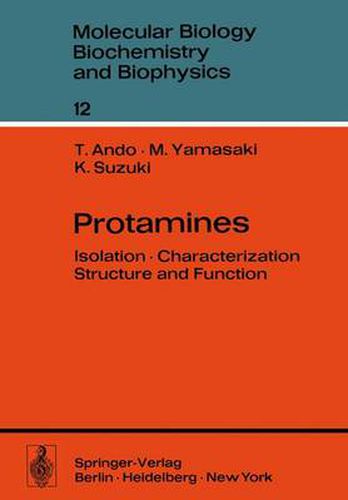Readings Newsletter
Become a Readings Member to make your shopping experience even easier.
Sign in or sign up for free!
You’re not far away from qualifying for FREE standard shipping within Australia
You’ve qualified for FREE standard shipping within Australia
The cart is loading…






This title is printed to order. This book may have been self-published. If so, we cannot guarantee the quality of the content. In the main most books will have gone through the editing process however some may not. We therefore suggest that you be aware of this before ordering this book. If in doubt check either the author or publisher’s details as we are unable to accept any returns unless they are faulty. Please contact us if you have any questions.
A century has already passed since FRIEDRICH MIESCHER, working at Strasbourg and Basel, began his study of protamine, one of the basic nuclear proteins of cells. It was first established by KOSSEL that protamine represents the simplest known protein. In the conviction that research into the nature of protamine would shed light on that of other typical proteins, a group of researchers in Germany followed MIESCHER and laid the foundations of protein chemistry. A general view of prot amines was thus built up by KOSSEL, working at Strasbourg, Berlin, Marburg an der Lahn, and Heidelberg, FELIX at Heidelberg, Munich, and Frankfurt am Main, and WALDSCHMIDT-LEITZ at Prague and Munich. Concepts and techniques established by these studies have been widely utilized for research on other typical proteins. The revolutionary advances in chemical and physical techniques after W orId War II extended the sphere of research to Tokyo in the Far East. Prof. FELIX’ visit in 1955 greatly encouraged our research group in Tokyo. His death in August 1960 constituted a sad loss to protein chemistry and stimulated our group to assume responsibility for carrying on the studies. In the following decade we in Tokyo have been able to add a new development to the results on the chemical structure of protamines accumulated by the Eurqpean researchers over a period of about fifty years.
$9.00 standard shipping within Australia
FREE standard shipping within Australia for orders over $100.00
Express & International shipping calculated at checkout
This title is printed to order. This book may have been self-published. If so, we cannot guarantee the quality of the content. In the main most books will have gone through the editing process however some may not. We therefore suggest that you be aware of this before ordering this book. If in doubt check either the author or publisher’s details as we are unable to accept any returns unless they are faulty. Please contact us if you have any questions.
A century has already passed since FRIEDRICH MIESCHER, working at Strasbourg and Basel, began his study of protamine, one of the basic nuclear proteins of cells. It was first established by KOSSEL that protamine represents the simplest known protein. In the conviction that research into the nature of protamine would shed light on that of other typical proteins, a group of researchers in Germany followed MIESCHER and laid the foundations of protein chemistry. A general view of prot amines was thus built up by KOSSEL, working at Strasbourg, Berlin, Marburg an der Lahn, and Heidelberg, FELIX at Heidelberg, Munich, and Frankfurt am Main, and WALDSCHMIDT-LEITZ at Prague and Munich. Concepts and techniques established by these studies have been widely utilized for research on other typical proteins. The revolutionary advances in chemical and physical techniques after W orId War II extended the sphere of research to Tokyo in the Far East. Prof. FELIX’ visit in 1955 greatly encouraged our research group in Tokyo. His death in August 1960 constituted a sad loss to protein chemistry and stimulated our group to assume responsibility for carrying on the studies. In the following decade we in Tokyo have been able to add a new development to the results on the chemical structure of protamines accumulated by the Eurqpean researchers over a period of about fifty years.